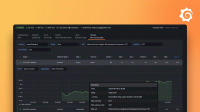Caution
Grafana Alloy is the new name for our distribution of the OTel collector. Grafana Agent has been deprecated and is in Long-Term Support (LTS) through October 31, 2025. Grafana Agent will reach an End-of-Life (EOL) on November 1, 2025. Read more about why we recommend migrating to Grafana Alloy.
Run Grafana Agent Flow as a standalone binary
If you downloaded the standalone binary, you must run Grafana Agent Flow from a terminal or command window.
Start Grafana Agent Flow on Linux, macOS, or FreeBSD
To start Grafana Agent Flow on Linux, macOS, or FreeBSD, run the following command in a terminal window:
AGENT_MODE=flow <BINARY_PATH> run <CONFIG_PATH>Replace the following:
<BINARY_PATH>: The path to the Grafana Agent Flow binary file.<CONFIG_PATH>: The path to the Grafana Agent Flow configuration file.
Start Grafana Agent Flow on Windows
To start Grafana Agent Flow on Windows, run the following commands in a command prompt:
set AGENT_MODE=flow
<BINARY_PATH> run <CONFIG_PATH>Replace the following:
<BINARY_PATH>: The path to the Grafana Agent Flow binary file.<CONFIG_PATH>: The path to the Grafana Agent Flow configuration file.
Set up Grafana Agent Flow as a Linux systemd service
You can set up and manage the standalone binary for Grafana Agent Flow as a Linux systemd service.
Note
These steps assume you have a default systemd and Grafana Agent Flow configuration.
To create a new user called
grafana-agent-flowrun the following command in a terminal window:sudo useradd --no-create-home --shell /bin/false grafana-agent-flowCreate a service file in
/etc/systemd/systemcalledgrafana-agent-flow.servicewith the following contents:[Unit] Description=Vendor-neutral programmable observability pipelines. Documentation=https://grafana.com/docs/agent/latest/flow/ Wants=network-online.target After=network-online.target [Service] Restart=always User=grafana-agent-flow Environment=HOSTNAME=%H EnvironmentFile=/etc/default/grafana-agent-flow WorkingDirectory=<WORKING_DIRECTORY> ExecStart=<BINARY_PATH> run $CUSTOM_ARGS --storage.path=<WORKING_DIRECTORY> $CONFIG_FILE ExecReload=/usr/bin/env kill -HUP $MAINPID TimeoutStopSec=20s SendSIGKILL=no [Install] WantedBy=multi-user.targetReplace the following:
<BINARY_PATH>: The path to the Grafana Agent Flow binary file.<WORKING_DIRECTORY>: The path to a working directory, for example/var/lib/grafana-agent-flow.
Create an environment file in
/etc/default/calledgrafana-agent-flowwith the following contents:## Path: ## Description: Grafana Agent Flow settings ## Type: string ## Default: "" ## ServiceRestart: grafana-agent-flow # # Command line options for grafana-agent # # The configuration file holding the Grafana Agent Flow configuration. CONFIG_FILE="<CONFIG_PATH>" # User-defined arguments to pass to the run command. CUSTOM_ARGS="" # Restart on system upgrade. Defaults to true. RESTART_ON_UPGRADE=trueReplace the following:
<CONFIG_PATH>: The path to the Grafana Agent Flow configuration file.
To reload the service files, run the following command in a terminal window:
sudo systemctl daemon-reloadUse the Linux systemd commands to manage your standalone Linux installation of Grafana Agent Flow.



